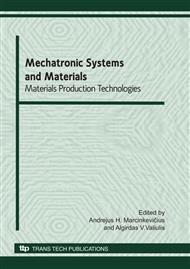[1]
J. Sato, T. Omori, K. Oikawa, I. Ohnuma, R. Kainuma, K. Ishida: Cobalt-Base HighTemperature Alloys, Vol 312 (2006 ).
DOI: 10.1126/science.1121738
Google Scholar
[2]
H. Singh, D. Puri, S. Prakash: Some studies on hot corrosion performance of plasma sprayed coatings on a Fe-based superalloy. Surface & Coatings Technology, Vol. 192 (2005), pp.27-38.
DOI: 10.1016/j.surfcoat.2004.03.030
Google Scholar
[3]
A. E. Yaedu; A. S. C. M. D'Oliveira: Cobalt based alloy PTA hardfacing on different substrate steels; Materials Science and Technology. Materials Science and Technology, Vol. 21, Iss. 4 (2005), pp.459-466.
DOI: 10.1179/174328413x13789824293380
Google Scholar
[4]
U. de Oliveira, V. Ocelík, J. Th.M. De Hosson: Residual stress analysis in Co-based laser clad layers by laboratory X-rays and synchrotron diffraction techniques. Surface & Coatings Technology, Vol. 201 (2006), pp.533-542.
DOI: 10.1016/j.surfcoat.2005.12.011
Google Scholar
[5]
D. E. Jones, J. Stringer: The Effect of Small Amounts of Silicon on the Oxidation of High-Purity Co-25 wt. % Cr at Elevated Temperatures. Oxidation of Metals, Vol. 9, No. 5 (1975), p.409413.
DOI: 10.1007/bf00611689
Google Scholar
[6]
P. Berthod, S. Michon, L. Aranda, S. Mathieu, J.C. Gachon: Experimental and thermodynamic study of the microstructure evolution in cobalt-base superalloys at high temperature. Computer Coupling of Phase Diagrams and Thermochemistry, Vol. 27 (2003).
DOI: 10.1016/j.calphad.2004.01.001
Google Scholar
[7]
J. J. Tigrinho, A. S. C. M. D'Oliveira: Plasma transferred arc surface modification of a low carbon steel. J Mater Sci, Vol. 42 (2007), pp.7554-7557.
DOI: 10.1007/s10853-007-1615-9
Google Scholar
[8]
A. S. C. M. D'Oliveira, R. S. C. Paredes, R. L. C. Santos: Pulsed current plasma transferred arc hardfacing. Journal of Materials Processing Technology, Vol. 171 (2006), pp.167-174.
DOI: 10.1016/j.jmatprotec.2005.02.269
Google Scholar
[9]
Gatto, E. Bassoli, M. Fornari: Plasma Transferred Arc deposition of powdered high performances alloys: process parameters optimisation as a function of alloy and geometrical configuration. Surface and Coatings Technology, Vol. 187, Iss. 2-3 (2004).
DOI: 10.1016/j.surfcoat.2004.02.013
Google Scholar
[10]
S. Niederhauser. B. Karlsson: Mechanical properties of laser cladded steel. Material Science and Technology, Vol. 19 (2003), pp.1611-1616.
DOI: 10.1179/026708303225008103
Google Scholar
[11]
R. Jendrzejewski, C. Navas, A. Conde, J. J. de Damborenea, G. Śliwiński: Properties of laser-cladded stellite coatings prepared on preheated chromium steel. Materials and Design, Vol. 29 (2008), pp.187-192.
DOI: 10.1016/j.matdes.2006.10.020
Google Scholar


